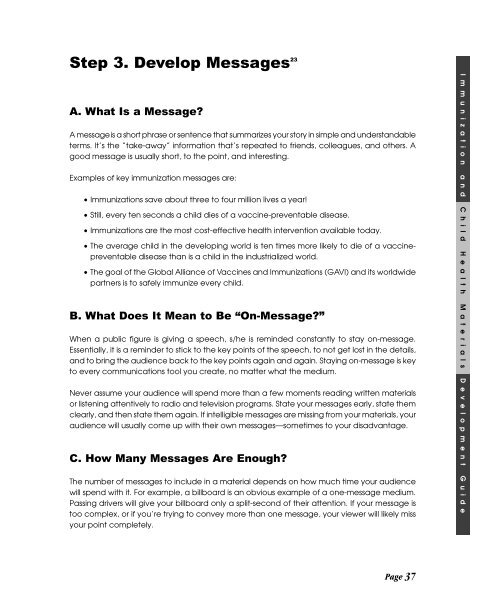Immunization and child health materials development guide pdf
Immunization and child health materials development guide pdf
Immunization and child health materials development guide pdf
You also want an ePaper? Increase the reach of your titles
YUMPU automatically turns print PDFs into web optimized ePapers that Google loves.
Step 3. Develop Messages 23<br />
A. What Is a Message?<br />
A message is a short phrase or sentence that summarizes your story in simple <strong>and</strong> underst<strong>and</strong>able<br />
terms. It’s the “take-away” information that’s repeated to friends, colleagues, <strong>and</strong> others. A<br />
good message is usually short, to the point, <strong>and</strong> interesting.<br />
Examples of key immunization messages are:<br />
• <strong>Immunization</strong>s save about three to four million lives a year!<br />
• Still, every ten seconds a <strong>child</strong> dies of a vaccine-preventable disease.<br />
• <strong>Immunization</strong>s are the most cost-effective <strong>health</strong> intervention available today.<br />
• The average <strong>child</strong> in the developing world is ten times more likely to die of a vaccinepreventable<br />
disease than is a <strong>child</strong> in the industrialized world.<br />
• The goal of the Global Alliance of Vaccines <strong>and</strong> <strong>Immunization</strong>s (GAVI) <strong>and</strong> its worldwide<br />
partners is to safely immunize every <strong>child</strong>.<br />
B. What Does It Mean to Be “On-Message?”<br />
When a public figure is giving a speech, s/he is reminded constantly to stay on-message.<br />
Essentially, it is a reminder to stick to the key points of the speech, to not get lost in the details,<br />
<strong>and</strong> to bring the audience back to the key points again <strong>and</strong> again. Staying on-message is key<br />
to every communications tool you create, no matter what the medium.<br />
Never assume your audience will spend more than a few moments reading written <strong>materials</strong><br />
or listening attentively to radio <strong>and</strong> television programs. State your messages early, state them<br />
clearly, <strong>and</strong> then state them again. If intelligible messages are missing from your <strong>materials</strong>, your<br />
audience will usually come up with their own messages—sometimes to your disadvantage.<br />
C. How Many Messages Are Enough?<br />
The number of messages to include in a material depends on how much time your audience<br />
will spend with it. For example, a billboard is an obvious example of a one-message medium.<br />
Passing drivers will give your billboard only a split-second of their attention. If your message is<br />
too complex, or if you’re trying to convey more than one message, your viewer will likely miss<br />
your point completely.<br />
Page 37

















